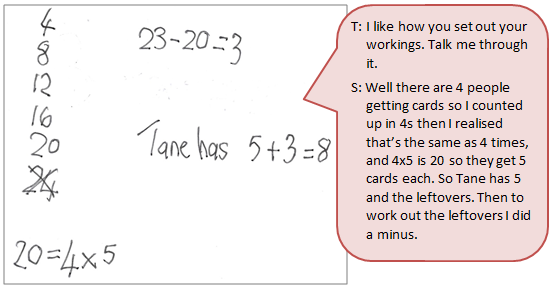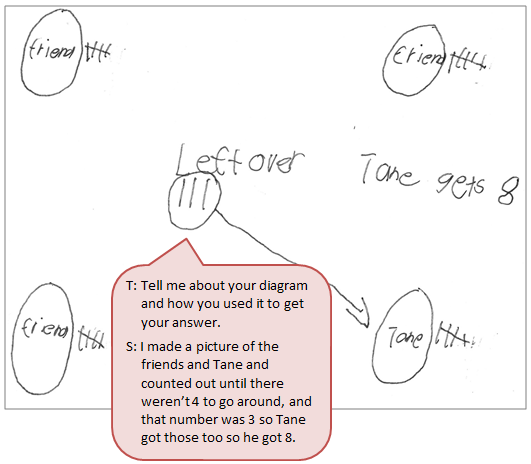The purpose of this activity is to engage students in solving a division problem that involves a remainder.
This activity assumes the students have experience in the following areas:
- Partitioning whole numbers to make calculations easier.
- Equally sharing sets and expressing the actions as division.
- Solving simple division problems with remainders.
The problem is sufficiently open ended to allow the students freedom of choice in their approach. It may be scaffolded with guidance that leads to a solution, and/or the students might be given the opportunity to solve the problem independently.
The example responses at the end of the resource give an indication of the kind of response to expect from students who approach the problem in particular ways.

Tane has 23 collector cards that he wants to share with his three friends.
He deals the cards out evenly to himself and to each of his friends, then he keeps the leftovers himself.
How many cards does Tane have after sharing?
The following prompts illustrate how this activity can be structured around the phases of the Mathematics Investigation Cycle.
Make sense
Introduce the problem. Allow students time to read it and discuss in pairs or small groups.
- Do I understand the situation and the words? (Students may need support to understand the meaning problem. Acting out the sharing may be needed. Clarify what cards Tane retains.)
- What are the key words in the problem?
- Can I represent the problem as a diagram? As a number operation?
- What kind of a maths problem is this one? How do I know?
- What will my solution look like? (The solution will be the number of cards Tane will get for himself. The solution will need to be explained and justified.)
Plan approach
Discuss ideas about how to solve the problem. Emphasise that, in the planning phase, you want students to say how they would solve the problem, not to actually solve it.
- What strategies will be useful to solve a problem like this? (Acting out, drawing a diagram, making a model, trying a simpler problem, and writing an equation are all possible strategies.)
- Do I have some idea of how many cards each friend will get? How do I know that?
- What facts will be helpful if there are 3 friends? How do you know?
- What tools (digital or physical) could help my investigation? Do I need a calculator or can I use mental or paper strategies?
Take action
Allow students time to work through their strategy and find a solution to the problem.
- Have I shown my workings in a step-by-step way?
- Is the working clear so I can follow it?
- Was there a pattern I can use on other similar problems?
- Have I found a solution? Is my solution sensible? How do I know?
- How can I express my solution using diagrams, numbers and words?
- Does my strategy work for other equal sharing situations?
- How do my results look different or different to others? Why could this be?
- What are the most efficient ways to solve the problem?
Convince yourself and others
Allow students time to check their answers and then either have them pair share with other groups or ask for volunteers to share their solution with the class.
- Is my working clear for someone else to follow?
- Did others get the same answer? Did they use the same strategies as me?
- How would I convince someone else I am correct?
- Is my solution expressed in a mathematical way? Do I need to learn some maths about how to express what I found?
- Would my strategy work in a different equal sharing situation?
- What would the answer be if I changed the number of friends? How would that affect the remainder and the number of cards Tane gets?
- Can I come up with a solution set for the numbers of friends, 1 up to 22?
Examples of work
Work sample 1
The student solves the problem for 3 friends and gets Tane’s share of the cards using equations.
Work sample 2
The student uses tally marks to diagrammatically work out the equal shares for the 3 friends scenario.
Click on the image to enlarge it. Click again to close.
The visual approach (show more)
- The student is able to represent a partitioning problem, with a diagram, to find a solution.
Prompts from the teacher could be:
- How can you represent this problem with a diagram?
- How many cards can they each have out of the 23?
- How many cards will be left over?
- How many cards will Tane get?

